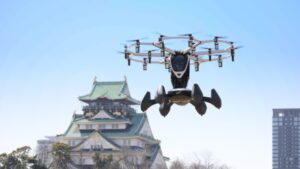
LIFT Aircraft, a pioneer in the development of eVTOL (electric vertical takeoff and landing) aircraft, has completed the first-ever piloted eVTOL demonstration flights in Japan. The demonstrations were conducted using LIFT’s HEXA aircraft in collaboration with Marubeni Corporation, a partner of LIFT Aircraft in the development and advancement of Japan’s eVTOL market, and GMO Internet Group.
The demonstrations were held as part of the Osaka Prefectural Government’s FY2022 Subsidy for Urban Business Creation Flying Car Projects and as a Candidate Demonstrator for Expo 2025, the Japan Association’s project for the 2025 World Exposition and the Osaka Chamber of Commerce and Industry. The flights were attended by Japan’s aviation authority, the Japan Civil Aviation Bureau (JCAB), which meticulously evaluated the aircraft’s safety and test program before granting permission for the demonstrations to begin.
The demonstrations showcased the capabilities of LIFT’s HEXA aircraft, which conforms to FAA Part 103 for operation within the U.S. without aircraft type certification or a pilot’s license. Japan lacks an equivalent regulation, and the JCAB’s approval was a significant achievement for LIFT Aircraft.
“JCAB was thorough in their review of our safety standards and our aircraft, and gave us the green light to fly,” said LIFT Aircraft founder and CEO Matt Chasen. “It’s an honor that our aircraft was selected to be the first eVTOL ever piloted in Japan.”
LIFT Aircraft has formally concluded Phase 1 flight test and beginner flight envelope development with the U.S. Air Force and has launched Alpha Flights, enabling operation by people outside of their Flight Operations and Test teams. GMO Internet Group’s Masatoshi Kumagai successfully piloted HEXA and completed three flight patterns after only around an hour of training and introduction to the aircraft during the demonstrations. A total of nine flights were completed in Osaka, with LIFT and Marubeni continuing their Japan demo tour in Niihama and Imabari next week.
“This is a strong indication to the world, and especially the thousands on our waitlist, that they will have the opportunity to fly very soon,” said Chasen. With the successful demonstrations, LIFT Aircraft has taken a significant step towards expanding the reach of eVTOL aircraft and demonstrating their capabilities to the world.
eVTOL
Electric Vertical Take-Off and Landing (eVTOL) aircraft are the future of urban air mobility, revolutionizing transportation and offering a more sustainable, efficient and convenient way to travel. eVTOLs are a type of VTOL (Vertical Take-Off and Landing) aircraft that use electric power to hover, take off, and land vertically. The use of electric power in eVTOLs is driven by major advances in electric propulsion technology, including motors, batteries, fuel cells, and electronic controllers.
With the rising need for new aerial vehicles that can enable greener and quieter flights, eVTOL technology has gained significant traction in recent years. Electric and hybrid propulsion systems (EHPS) used in eVTOLs also have the potential of lowering the operating costs of aircraft. By utilizing electric power, eVTOLs can offer a clean and quiet alternative to conventional aircraft, reducing noise pollution and carbon emissions, while also providing greater flexibility in terms of take-off and landing locations.
A number of original equipment manufacturers (OEMs) are developing eVTOL aircraft, including legacy manufacturers like Airbus, Boeing, Embraer, Honda, Hyundai, and Toyota, as well as several start-up companies like Archer Aviation, EHang, Joby Aviation, Overair, and Volocopter. The ecosystem of firms developing eVTOLs also includes spin-offs of legacy aircraft manufacturers, such as Eve Air Mobility that emerged from the EmbraerX division of Embraer. Partnerships such as Wisk Aero, which was launched as a joint venture between Boeing and Larry Page’s Kitty Hawk, are also contributing to the development of eVTOLs.
The advantages of eVTOL technology are numerous. With the ability to take off and land vertically, eVTOLs can provide convenient and efficient travel in urban areas. They can also be used for emergency response, medical transport, and search and rescue operations in remote locations. Additionally, eVTOLs can help reduce road congestion, and provide greater accessibility to hard-to-reach areas, making them an attractive option for governments and transportation companies alike.
The eVTOL market is rapidly evolving, and its potential impact on the aviation industry is significant. With the development of new technologies and increased investment, eVTOLs are set to play a key role in the future of air transportation, providing a safer, more sustainable, and more efficient way to travel.